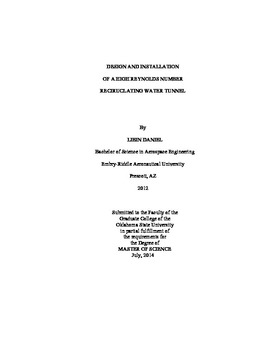| dc.contributor.advisor | Elbing, Brian R. | |
| dc.contributor.author | Daniel, Libin | |
| dc.date.accessioned | 2015-06-17T20:05:27Z | |
| dc.date.available | 2015-06-17T20:05:27Z | |
| dc.date.issued | 2014-07-01 | |
| dc.identifier.uri | https://hdl.handle.net/11244/14791 | |
| dc.description.abstract | The High-Reynolds Number Fluid Mechanics Laboratory has recently been established at Oklahoma State University (OSU). The three primary components of the laboratory are 1) a recirculating water tunnel, 2) a multiphase pipe flow facility, and 3) a multi-scale flow visualization system. This thesis focuses on the design and fabrication of the water tunnel, which will be used for high-Reynolds number turbulent boundary layer research.Two main design criteria for the water tunnel were to achieve a momentum thickness based Reynolds number in excess of 104 and to have high optical access to the flow surfaces in the test section. This is being achieved with a 1 m. long test section and a maximum flow speed of 10 m/s. This Reynolds number was targeted to bridge the gap between typical university water tunnels (103) and the world's largest water tunnel facilities (105). The water tunnel is powered by a 150 hp motor and a 4500 gpm capacity centrifugal pump. The water tunnel is designed for a maximum operating pressure of 40 psi. This will make the facility a low cost option to perform high-Reynolds number aerodynamic and hydrodynamic tests. Improved flow imaging capability is a major advantage to liquid based fluid facilities because of the increased density for seeding and reduced field-of-view for equivalent Reynolds number. The laboratory's state-of-the-art flow visualization system can be used for time-resolved and phase averaged stereo- particle-image-velocimetry (sPIV), laser-induced-fluorescence, and high-speed imaging. Design provisions are also made to allow a multi-phase loop to share the pump and motor configuration of this water tunnel facility.The major design decisions that went into the design of the water tunnel facility are discussed. The design considerations that were taken into account for the test section, flow conditioning sections and the entire flow loop are discussed in greater detail. The final configuration and the technical drawings of the water tunnel flow loop, the test section, the contraction and diffuser sections are also provided. The installation procedure that will be utilized to install the water tunnel in the High Reynolds Number Fluid Mechanics Laboratory is also discussed. | |
| dc.format | application/pdf | |
| dc.language | en_US | |
| dc.publisher | Oklahoma State University | |
| dc.rights | Copyright is held by the author who has granted the Oklahoma State University Library the non-exclusive right to share this material in its institutional repository. Contact Digital Library Services at lib-dls@okstate.edu or 405-744-9161 for the permission policy on the use, reproduction or distribution of this material. | |
| dc.title | Design and Installation of a High Reynolds Number Recirculating Water Tunnel | |
| dc.type | text | |
| dc.contributor.committeeMember | Jacob, Jamey D. | |
| dc.contributor.committeeMember | Santhanakrishnan, Arvind | |
| osu.filename | Daniel_okstate_0664M_13512.pdf | |
| osu.accesstype | Open Access | |
| dc.description.department | Mechanical Engineering | |
| dc.type.genre | Thesis | |
| dc.subject.keywords | drag reduction | |
| dc.subject.keywords | engineering design | |
| dc.subject.keywords | fluid mechanics | |
| dc.subject.keywords | reynolds number | |
| dc.subject.keywords | turbulent boundary layer | |
| dc.subject.keywords | water tunnel | |
